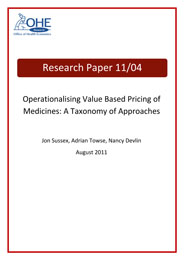Recent reforms to the National Health Service (NHS) in England include important changes in the regulation of prices for new medicines. From January 2014, the existing…
Recent reforms to the National Health Service (NHS) in England include important changes in the regulation of prices for new medicines. From January 2014, the existing Pharmaceutical Pricing Regulation Scheme (PPRS) will be replaced by “value based pricing” (VBP) for branded medicines sold…
Recent reforms to the National Health Service (NHS) in England include important changes in the regulation of prices for new medicines. From January 2014, the existing Pharmaceutical Pricing Regulation Scheme (PPRS) will be replaced by “value based pricing” (VBP) for branded medicines sold to the NHS. This will apply only to new medicines; those marketed before 2014 will continue to be governed by the PPRS.
To date, the UK Government has not been specific about how VBP will be implemented, but has indicated that calculations of value will extend beyond the QALY approach currently used by NICE. The Department of Health has stated that it will include “the range of factors through which medicines deliver benefits for patients and society”.
In this OHE Research Paper, the authors identify and describe the full set of possible means by which value based pricing might be operationalised, categorise these by developing a taxonomy of approaches, and provide an initial assessment of the challenges, pros and cons of each. They review the elements of value that could be considered and how these might be measured and valued, combined into an overall assessment of a medicine’s value,and then linked to the maximum price the health service is willing to reimburse. Finally, they review the means by which VBP is currently operationalised in a selection of countries and place these, and proposals for the UK, in the context of the taxonomy.
A revised version of this paper has been published in PharmacoEconomics and can be downloaded from: http://link.springer.com/article/10.1007%2Fs40273-012-0001-x
Please cite as: Sussex, J., Towse, A. and Devlin, N., 2013. Operationalizing value-based pricing of medicines. PharmacoEconomics, 31(1), pp.1-10.
